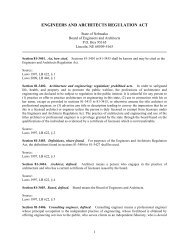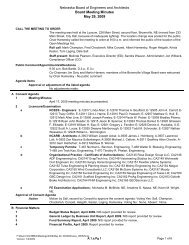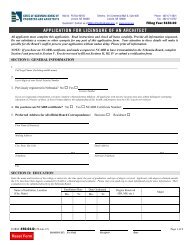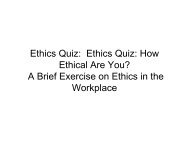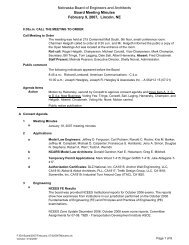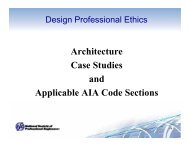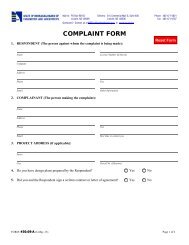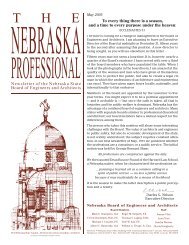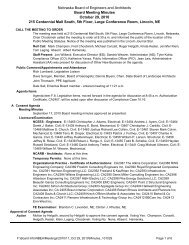Winter 2011 - Nebraska Board of Engineers and Architects - State of ...
Winter 2011 - Nebraska Board of Engineers and Architects - State of ...
Winter 2011 - Nebraska Board of Engineers and Architects - State of ...
You also want an ePaper? Increase the reach of your titles
YUMPU automatically turns print PDFs into web optimized ePapers that Google loves.
The <strong>Nebraska</strong><br />
PROFESSIONAL<br />
<strong>Nebraska</strong> <strong>Board</strong> <strong>of</strong> <strong>Engineers</strong> <strong>and</strong> <strong>Architects</strong> Newsletter<br />
<strong>Winter</strong> <strong>2011</strong><br />
Negotiated Rulemaking Results<br />
The <strong>Nebraska</strong> <strong>Board</strong> <strong>of</strong> <strong>Engineers</strong><br />
<strong>and</strong> <strong>Architects</strong> convened a Negotiated<br />
Rulemaking Committee last summer with<br />
the purpose <strong>of</strong> exploring NCEES<br />
proposed changes<br />
affecting several existing provisions in<br />
the <strong>Nebraska</strong> <strong>Engineers</strong><br />
NEWS<br />
<strong>and</strong> <strong>Architects</strong><br />
Regulation Act. Negotiated rulemaking is<br />
a process that allows state agencies the<br />
opportunity to resolve controversial issues by<br />
enlisting the direct participation <strong>of</strong> interested<br />
parties prior to the commencement <strong>of</strong> formal<br />
rulemaking.<br />
The <strong>Board</strong> invited a large number <strong>of</strong><br />
groups to participate including contractors,<br />
members <strong>of</strong> the engineering <strong>and</strong> architecture<br />
pr<strong>of</strong>essions, municipalities, county <strong>of</strong>ficials,<br />
insurers, realtors, <strong>and</strong> a number <strong>of</strong> state<br />
agencies including the <strong>State</strong> Fire Marshal,<br />
<strong>State</strong> Electrical <strong>Board</strong>, the Department<br />
<strong>of</strong> Environmental Quality <strong>and</strong> Natural<br />
Resources Districts.<br />
The <strong>Board</strong> identified two issues <strong>of</strong> particular<br />
relevance for the committee to consider.<br />
The first was the possible elimination<br />
<strong>of</strong> exemptions in some occupancy<br />
classifications, as described in Rule 10.3,<br />
to increase the safety <strong>of</strong> people utilizing<br />
structures in which:<br />
• large numbers <strong>of</strong> occupants congregate<br />
in a small area;<br />
<strong>Board</strong> Members<br />
Fred Choobineh - Chair, Engineer Member, Lincoln<br />
Krista Kester - Vice Chair, Public Member, Lincoln<br />
Roger Helgoth - Secretary, Engineer Member, Omaha<br />
Mark Champion - Architect Member, Lincoln<br />
Michael Conzett - Engineer Member, Ralston<br />
Albert Hamersky - Architect Member, Lincoln<br />
Jennifer Klein - Engineer Member, Lincoln<br />
Thomas Laging - Architect Member, Lincoln<br />
Staff<br />
Jon Wilbeck - Executive Director<br />
S<strong>and</strong>ra Weaver - Administrator<br />
Tyler Kohtz - Compliance Officer<br />
Katherine Yañez - Public Information Officer<br />
Jean Lais - Administrative Assistant<br />
Jeanne Vliet - Receptionist<br />
Michelle Thober - Staff Assistant<br />
• occupants cannot self-preserve, such<br />
as children in daycare, jail inmates or<br />
healthcare patients; or<br />
NCARB<br />
• where hazardous materials are being<br />
stored or used.<br />
NEWS<br />
The second issue to consider was a proposal<br />
allowing limited “cross-discipline” practice<br />
between engineering <strong>and</strong> architecture, which<br />
would provide licensed pr<strong>of</strong>essionals the<br />
ability to conduct limited practice outside their<br />
area <strong>of</strong> licensure. More simply, architects<br />
could practice limited engineering, <strong>and</strong><br />
pr<strong>of</strong>essional engineers could practice limited<br />
architecture if they are competent to do so.<br />
The Negotiated Rulemaking Committee<br />
considered these issues at three separate<br />
meetings held in Lincoln last July <strong>and</strong><br />
August. A neutral facilitator was selected by<br />
the <strong>Board</strong> to preside over the meetings <strong>and</strong><br />
assist committee members in conducting<br />
discussions <strong>and</strong> negotiations.<br />
Discussion <strong>of</strong> the two issues brought<br />
forth differing sets <strong>of</strong> opinions from the 23<br />
members <strong>of</strong> the committee. The goal <strong>of</strong><br />
the rulemaking process was to achieve<br />
substantial agreement regarding the<br />
proposed changes; enough to develop<br />
recommended policies <strong>and</strong> language for<br />
submission to the <strong>Board</strong>.<br />
Giving weight to the opinions <strong>and</strong> perspective<br />
<strong>of</strong> the delegates was a final vote cast by<br />
each to approve or oppose the committee’s<br />
recommendations regarding the elimination<br />
<strong>of</strong> certain matrix exemptions <strong>and</strong> crossdisciplinary<br />
practice in the state. Of the two<br />
issues, only the latter received consensus<br />
approval as defined by the committee.<br />
Cross-Disciplinary Practice<br />
Recommendations<br />
There were 12 votes to approve, none<br />
to oppose, the proposal allowing limited<br />
continued on page 3<br />
Lincoln Community Foundation Building • 215 Centennial Mall South Suite 400 • Lincoln, NE 68508<br />
P.O Box 95165 • Lincoln, NE 68509<br />
Proposed Statute<br />
Changes<br />
Jon Wilbeck<br />
Executive Director<br />
The following is a list<br />
outlining major proposed<br />
statutory changes to the<br />
<strong>Engineers</strong> <strong>and</strong> <strong>Architects</strong><br />
Regulation Act. The <strong>Board</strong><br />
is actively pursuing these<br />
changes in the current<br />
state legislative session,<br />
which began January 5 th . Changes were<br />
recommended to the <strong>Board</strong> by its Legislative<br />
Committee; made up <strong>of</strong> <strong>Board</strong> members<br />
Albert Hamersky, Roger Helgoth, Krista<br />
Kester, as well as myself <strong>and</strong> Rich Lombardi<br />
<strong>of</strong> American Communications.<br />
The changes on cross-discipline practice<br />
are based, in part, from a consensus<br />
recommendation submitted by the<br />
Negotiated Rulemaking Committee (see<br />
Negotiated Rulemaking Results). The list<br />
also includes changes <strong>of</strong> a more technical<br />
nature. Based on suggestions noted by<br />
its staff, the <strong>Board</strong> will pursue revisions to<br />
accommodate the introduction <strong>of</strong> the new 16-<br />
hour NCEES Structural II exam.<br />
Phone: 402.471.2021 • Fax: 402.471.0787 • Email: nbea.<strong>of</strong>fice@nebraska.gov • www.ea.ne.gov<br />
continued on page 2
Proposed Statute Changes (continued from page 1)<br />
Note: Where actual statutory language<br />
is presented; additions to statute are<br />
bold <strong>and</strong> underlined, deletions are noted<br />
with a strikethrough. Commentary, where<br />
applicable, has also been included to<br />
expound on the language contained in the<br />
statute.<br />
81-3429. <strong>Board</strong>; members;<br />
requirements; per diem; expenses.<br />
… Each member <strong>of</strong> the board shall<br />
receive as compensation not more than<br />
sixty dollars per day for each day or<br />
substantial part <strong>of</strong> a day actually spent in<br />
traveling to <strong>and</strong> from <strong>and</strong> while attending<br />
sessions <strong>of</strong> the board <strong>and</strong> its committees,<br />
or authorized meetings <strong>of</strong> the National<br />
Council <strong>of</strong> Architectural Registration<br />
<strong>Board</strong>s, the National Council <strong>of</strong> Examiners<br />
for Engineering <strong>and</strong> Surveying, or their<br />
subdivisions or committees, or for other<br />
authorized business <strong>of</strong> the board, <strong>and</strong> all<br />
necessary expenses incident to the<br />
performance <strong>of</strong> his or her duties under the<br />
<strong>Engineers</strong> <strong>and</strong> <strong>Architects</strong> Regulation Act as<br />
provided in sections 81-1174 to 81-1177.<br />
» The change slightly clarifies <strong>and</strong> exp<strong>and</strong>s<br />
the criteria for per diem payments to <strong>Board</strong><br />
members.<br />
81-3442. Prohibited acts; penalties.<br />
Any person who performs any <strong>of</strong> the<br />
following actions is guilty <strong>of</strong> a Class I<br />
misdemeanor for the first <strong>of</strong>fense <strong>and</strong><br />
a Class IV felony for the second or any<br />
subsequent <strong>of</strong>fense:<br />
(1) Practices or <strong>of</strong>fers to practice<br />
architecture or engineering in this state<br />
without being licensed in accordance with<br />
the <strong>Engineers</strong> <strong>and</strong> <strong>Architects</strong> Regulation<br />
Act, unless such practice or <strong>of</strong>fer to practice is<br />
otherwise exempt under the Act;<br />
81-3449. Practice <strong>of</strong> architecture;<br />
exempted activities.<br />
The provisions <strong>of</strong> the <strong>Engineers</strong> <strong>and</strong><br />
<strong>Architects</strong> Regulation Act regulating the<br />
practice <strong>of</strong> architecture do not apply to the<br />
following activities:<br />
(16) A licensed architect’s limited practice <strong>of</strong><br />
engineering in connection with any building,<br />
structure, or work classified as a business<br />
(except outpatient clinics), mercantile, storage,<br />
factory, or utility occupancy less than 6,000<br />
square feet in building area, provided that the<br />
architect certifies competence to perform the<br />
work as required by the board.<br />
81-3453. Practice <strong>of</strong> engineering;<br />
exempted activities.<br />
The provisions <strong>of</strong> the <strong>Engineers</strong> <strong>and</strong><br />
<strong>Architects</strong> Regulation Act regulating the<br />
practice <strong>of</strong> engineering do not apply to the<br />
following activities:<br />
<strong>2011</strong> UPCOMING EVENTS OF THE NBEA<br />
Jan 31 NBEA application deadline for PE first-time applications<br />
Feb 8 NBEA - UNL Visit - Sign up for April <strong>2011</strong> FE exam, Lincoln<br />
10 NBEA - UNO Visit - Sign up for April <strong>2011</strong> FE exam, Omaha<br />
10-12 NCEES <strong>Board</strong> Presidents Assembly, Atlanta, GA<br />
11 NBEA <strong>Board</strong> Meeting, 8:30 a.m., Lincoln, NE<br />
15 NBEA application deadline for all FE applications <strong>and</strong> PE<br />
retake applications<br />
18 NCEES exam registration deadline<br />
MAR 3 NBEA Strategic Planning Meeting, Lincoln, NE<br />
4 NBEA <strong>Board</strong> Meeting - 8:30 a.m., Lincoln, NE<br />
11-12 NCARB Regional Meeting, Jersey City, NJ<br />
APR 8-9 NCEES Engineering Examinations<br />
19 NBEA - UNL Visit - Sign up for Oct <strong>2011</strong> FE exam, Lincoln<br />
22 NBEA <strong>Board</strong> Meeting, 8:30 a.m., Lincoln, NE<br />
28 NBEA - UNO Visit - Sign up for Oct <strong>2011</strong> FE exam, Omaha<br />
MAY 5-7 NCEES Central Zone Meeting, Detroit, MI<br />
20 NBEA <strong>Board</strong> Meeting - 8:30 a.m., Lincoln, NE<br />
JUN 22-25<br />
NCARB Annual Meeting, Washinton, DC<br />
2<br />
(19) A licensed pr<strong>of</strong>essional engineer’s limited<br />
practice <strong>of</strong> architecture in connection with<br />
any building, structure, or work classified as a<br />
business (except outpatient clinics), mercantile,<br />
storage, factory, or utility occupancy less than<br />
6,000 square feet in building area, provided that<br />
the pr<strong>of</strong>essional engineer certifies competence<br />
to perform the work as required by the board.<br />
» These changes will allow for limited<br />
cross-discipline practice between<br />
the pr<strong>of</strong>essions <strong>of</strong> engineering <strong>and</strong><br />
architecture by licensed architects <strong>and</strong><br />
pr<strong>of</strong>essional engineers.<br />
81-3443. Enforcement procedures.<br />
Charges A complaint against any person or<br />
organization involving any matter coming<br />
within the jurisdiction <strong>of</strong> the board shall be<br />
in writing <strong>and</strong> shall be filed with the board.<br />
The charges complaint, at the discretion<br />
<strong>of</strong> the board, shall be heard within a<br />
reasonable time in accordance with the<br />
rules <strong>and</strong> regulations <strong>and</strong> may be heard<br />
through the use <strong>of</strong> a hearing <strong>of</strong>ficer. The<br />
accused shall have the right to appear<br />
personally with or without counsel, to<br />
cross-examine adverse witnesses, <strong>and</strong> to<br />
produce evidence <strong>and</strong> witnesses in his,<br />
her, or its or her defense. The board shall<br />
set the time <strong>and</strong> place for the hearing<br />
<strong>and</strong> shall cause a copy <strong>of</strong> the complaint<br />
charges, together with a notice <strong>of</strong> the time<br />
<strong>and</strong> place fixed for the hearing, to be sent<br />
by registered mail to the accused, at his,<br />
her, or its or her last-known business or<br />
residence address known to the board,<br />
at least thirty days before the hearing.<br />
If after the hearing the board finds the<br />
accused has violated the <strong>Engineers</strong> <strong>and</strong><br />
<strong>Architects</strong> Regulation Act or any rules or<br />
regulations, it may issue any order or take<br />
any action described in section 81-3444.<br />
If the board finds no violation, it shall enter<br />
an order dismissing the charges complaint.<br />
If the order revokes, suspends, or cancels<br />
a license, the board shall notify, in writing,<br />
the Secretary <strong>of</strong> <strong>State</strong> <strong>and</strong> the clerk <strong>of</strong> the<br />
city or village in the state where the person<br />
has a place <strong>of</strong> business, if any. The board<br />
may reissue a license to any person whose<br />
license that has been revoked. Application<br />
for the…<br />
81-3444. Disciplinary actions<br />
authorized; civil penalties.<br />
(1) The board may after hearing, by<br />
majority vote, take any or all <strong>of</strong> the<br />
following actions, upon pro<strong>of</strong> satisfactory to<br />
the board that any person or organization<br />
continued on page 4
Negotiated Rulemaking Results (continued from page 1)<br />
cross-discipline practice by licensed<br />
architects <strong>and</strong> pr<strong>of</strong>essional engineers<br />
between the pr<strong>of</strong>essions <strong>of</strong> engineering<br />
<strong>and</strong> architecture on projects <strong>of</strong> specific<br />
occupancies under 6,000 feet in size.<br />
The following language was prescribed<br />
<strong>and</strong> voted on by the Negotiated<br />
Rulemaking Committee:<br />
Any building, structure, or work which<br />
contains two or more occupancies<br />
shall use the most restrictive<br />
occupancy applied to the entire<br />
building for purposes <strong>of</strong> utilizing Rule<br />
10.3.<br />
Licensed architects may practice<br />
engineering in connection with any<br />
building, structure, or work classified<br />
as a business, mercantile, storage,<br />
factory, or utility occupancy less than<br />
6,000 square feet in building area,<br />
provided that the architect certifies<br />
competence to perform the work.<br />
Licensed pr<strong>of</strong>essional engineers may<br />
practice architecture in connection<br />
with any building structure, or work<br />
classified as a business, mercantile,<br />
storage, factory, or utility occupancy<br />
less than 6,000 square feet in building<br />
area, provided that the pr<strong>of</strong>essional<br />
engineer certifies competence to<br />
perform the work.<br />
The committee also approved a<br />
certification requirement in conjunction with<br />
the new rules. Proposed as either a rule<br />
or <strong>Board</strong> policy, pr<strong>of</strong>essionals engaging<br />
in cross-disciplinary practice would be<br />
required to affirm their competency to do<br />
so by signing a certification statement.<br />
While it was not agreed upon by the entire<br />
committee, most members supported<br />
having the statement appear on the cover<br />
sheet <strong>of</strong> design documents along with a<br />
listing <strong>of</strong> applicable page numbers.<br />
There were 11 votes in favor <strong>of</strong> the<br />
following certification language:<br />
I, (name <strong>of</strong> licensee), certify that I am<br />
a licensed design pr<strong>of</strong>essional who<br />
is competent to perform the (type <strong>of</strong><br />
work) based on my training, education,<br />
<strong>and</strong> experience. I also underst<strong>and</strong> the<br />
risk <strong>of</strong> being disciplined by the <strong>Board</strong><br />
if this portion <strong>of</strong> the work proves me<br />
to be incompetent <strong>and</strong> presents a<br />
risk to public health, life safety, <strong>and</strong>/or<br />
other hazards attributed to my design.<br />
The size <strong>of</strong> the project is within the<br />
prescribed limits defined in the E&A<br />
Act. I take full responsibility for my<br />
work.<br />
(signature), (date), (seal)<br />
Legislative Pursuits<br />
Since the Negotiated Rulemaking<br />
Committee was unable to reach a<br />
consensus on revisions to the exemption<br />
matrix in Rule 10.3, the <strong>Board</strong>-appointed<br />
Legislative Committee has provided the<br />
<strong>Board</strong> with a recommendation to suspend<br />
further pursuit <strong>of</strong> changes to the matrix<br />
at this time. This decision, however, does<br />
not eliminate the possibility <strong>of</strong> the <strong>Board</strong><br />
revisiting the issue in the future.<br />
While the original intent <strong>of</strong> the negotiated<br />
rulemaking process was to gather<br />
recommendations for proposed rule<br />
changes, the <strong>Board</strong>’s Legislative<br />
Committee felt that statutory changes<br />
were better suited for the cross-discipline<br />
practice provision. This approach is more<br />
conducive considering there are currently<br />
a number <strong>of</strong> statutory revisions that would<br />
need to take place in order for the new<br />
provision to work.<br />
<strong>Board</strong> efforts will now focus primarily on<br />
supporting statutory changes in favor <strong>of</strong><br />
the cross-discipline recommendations<br />
provided by the Negotiated Rulemaking<br />
Committee. In addition, the <strong>Board</strong> will<br />
address other minor <strong>and</strong>, in their view,<br />
non-controversial changes. To learn more<br />
about the Legislative Committee’s plans<br />
to move forward with the drafting <strong>of</strong> these<br />
legislative updates, see the accompanying<br />
article Proposed Statute Changes.<br />
Hamersky receives<br />
Cunningham Gold Medal<br />
<strong>Board</strong> member Albert Hamersky was awarded<br />
the Harry F. Cunningham Gold Medal at the<br />
AIA <strong>Nebraska</strong> Excellence in Design Gala<br />
last October. The Gold Medal represents AIA<br />
<strong>Nebraska</strong>’s highest honor <strong>and</strong> is awarded in<br />
recognition <strong>of</strong> distinguished achievements in<br />
architecture or service to the pr<strong>of</strong>ession <strong>of</strong><br />
architecture in the state.<br />
Hamersky has served a 20 year term with the<br />
<strong>Nebraska</strong> <strong>Board</strong> <strong>of</strong> <strong>Engineers</strong> <strong>and</strong> <strong>Architects</strong>. A<br />
licensed architect, he holds a Bachelor’s degree<br />
in Architecture from UNL <strong>and</strong> a Masters in<br />
Architecture from MIT.<br />
Kohtz appointed<br />
Compliance Officer<br />
In August, Tyler Kohtz<br />
joined the <strong>Nebraska</strong><br />
<strong>Board</strong> <strong>of</strong> <strong>Engineers</strong><br />
<strong>and</strong> <strong>Architects</strong> as<br />
compliance <strong>of</strong>ficer. The<br />
position, previously left<br />
vacant by the promotion<br />
<strong>of</strong> Jon Wilbeck to the<br />
role <strong>of</strong> executive director, is primarily<br />
responsible for investigating complaint<br />
cases submitted to the <strong>Board</strong>.<br />
Before joining the <strong>Board</strong>, Kohtz served<br />
as an unemployment insurance<br />
adjudicator for the <strong>Nebraska</strong> Department<br />
<strong>of</strong> Labor. As an adjudicator he gained<br />
experience applying both federal laws<br />
<strong>and</strong> state statutes to complex claims<br />
investigations. Prior to that experience<br />
Kohtz spent three years as a drafter for<br />
Chief Industries; working in both Gr<strong>and</strong><br />
Isl<strong>and</strong> <strong>and</strong> Omaha <strong>of</strong>fices.<br />
“We are pleased to have Tyler as the<br />
<strong>Board</strong>’s new compliance <strong>of</strong>ficer,” said<br />
Executive Director Jon Wilbeck. “His<br />
education <strong>and</strong> work experience have<br />
proved to be valuable assets in meeting<br />
the challenges <strong>of</strong> the position.”<br />
A native <strong>of</strong> <strong>Nebraska</strong>, Kohtz graduated<br />
from Chase County High School. After<br />
acquiring an Associate’s Degree in<br />
Drafting <strong>and</strong> Design, he went on to<br />
obtain a Bachelor’s Degree in Marketing<br />
Management from Bellevue University<br />
in 2008. Kohtz shares a home in Lincoln<br />
with his wife Wendy <strong>and</strong> their two dogs.<br />
The couple is expecting their first child in<br />
April.<br />
Pictured above: AIA <strong>Nebraska</strong> President Kristi Nohavec<br />
(right) <strong>and</strong> nominator Mark Champion (left) present Albert<br />
Hamersky with the gold medal award.<br />
3
Proposed Statute Changes (continued from page 2)<br />
has violated the <strong>Engineers</strong> <strong>and</strong> <strong>Architects</strong><br />
Regulation Act or any rules or regulations.<br />
Upon a finding that a person or organization<br />
committed a violation, the The following<br />
actions may be taken against such person<br />
or organization a holder <strong>of</strong> a license upon a twothirds<br />
majority vote <strong>of</strong> the board…<br />
» The ‘charges to complaint’ revisions are<br />
consistent with the de facto procedures the<br />
<strong>Board</strong> follows in investigating compliance<br />
cases. Additionally, complaints can be filed<br />
against organizations as well as licensees<br />
<strong>and</strong> non-licensed individuals.<br />
81-3444. Disciplinary actions<br />
authorized; civil penalties.<br />
(3) Civil penalties collected under<br />
subdivision (1)(e) <strong>of</strong> this section shall be<br />
remitted to the <strong>State</strong> Treasurer for credit<br />
to the permanent school fund distribution in<br />
accordance with Article VII, section 5, <strong>of</strong> the<br />
Constitution <strong>of</strong> <strong>Nebraska</strong>. All costs collected<br />
under …<br />
» Considered a minor change, the revision<br />
better represents the recommended<br />
language for distribution <strong>of</strong> civil penalty<br />
monies per the <strong>Nebraska</strong> Attorney General<br />
<strong>and</strong> the Legislature’s Revisor <strong>of</strong> Statutes.<br />
81-3449. Practice <strong>of</strong> architecture;<br />
exempted activities.<br />
The provisions <strong>of</strong> the <strong>Engineers</strong> <strong>and</strong><br />
<strong>Architects</strong> Regulation Act regulating the<br />
practice <strong>of</strong> architecture do not apply to the<br />
following activities:<br />
(4) Any public works project with<br />
contemplated expenditures for a completed<br />
project that do not exceed one hundred<br />
eighty-six thous<strong>and</strong> dollars. The board shall<br />
adjust the dollar amount in this subdivision<br />
every, every fifth year, with the first adjustment<br />
to be effective on July 1, 2014 commencing July 1,<br />
2009. The adjusted amount shall be equal<br />
to the then current amount adjusted by<br />
the cumulative percentage change in the<br />
Consumer Price Index …<br />
81-3453. Practice <strong>of</strong> engineering;<br />
exempted activities.<br />
The provisions <strong>of</strong> the <strong>Engineers</strong> <strong>and</strong><br />
<strong>Architects</strong> Regulation Act regulating the<br />
practice <strong>of</strong> engineering do not apply to the<br />
following activities:<br />
(4) Any public works project with<br />
contemplated expenditures for the<br />
completed project that do not exceed one<br />
hundred eighty-six thous<strong>and</strong> dollars. The<br />
board shall adjust the dollar amount in this<br />
subdivision every fifth year, with the first<br />
adjustment to be effective on commencing<br />
July 1, 2014 2009. The adjusted amount<br />
shall be equal to the then current amount<br />
adjusted by the cumulative percentage<br />
change in the Consumer Price Index for<br />
All Urban Consumers published by the<br />
Federal Bureau <strong>of</strong> Labor Statistics for the<br />
five-year period preceding the adjustment<br />
date. The amount shall be rounded to the<br />
next highest one-thous<strong>and</strong>-dollar amount;<br />
» The dollar amount for the public works<br />
exemption was adjusted on July 1, 2009 to<br />
$100,000 using the method described in<br />
the original statute. These edits allow for<br />
the next adjustment <strong>and</strong> are intended to<br />
eliminate misinterpretations <strong>of</strong> the statute.<br />
81-3449. Practice <strong>of</strong> architecture;<br />
exempted activities.<br />
The provisions <strong>of</strong> the <strong>Engineers</strong> <strong>and</strong><br />
<strong>Architects</strong> Regulation Act regulating the<br />
practice <strong>of</strong> architecture do not apply to the<br />
following activities:<br />
(12) The practice by qualified members <strong>of</strong><br />
other legally recognized pr<strong>of</strong>essions who are<br />
otherwise licensed or certified by this state to<br />
perform services consistent with the laws <strong>of</strong><br />
this state, the training, <strong>and</strong> the code <strong>of</strong> ethics<br />
<strong>of</strong> those respective pr<strong>of</strong>essions, provided<br />
such qualified members do not represent<br />
themselves to be practicing architecture <strong>and</strong><br />
do not represent themselves to be architects<br />
The practice <strong>of</strong> any other certified trade or legally<br />
recognized pr<strong>of</strong>ession;<br />
81-3453. Practice <strong>of</strong> engineering;<br />
exempted activities.<br />
The provisions <strong>of</strong> the <strong>Engineers</strong> <strong>and</strong><br />
<strong>Architects</strong> Regulation Act regulating the<br />
practice <strong>of</strong> engineering do not apply to the<br />
following activities:<br />
(8) The practice by qualified members <strong>of</strong><br />
other legally recognized pr<strong>of</strong>essions who are<br />
otherwise licensed or certified by this state to<br />
perform services consistent with the laws <strong>of</strong><br />
this state, the training, <strong>and</strong> the code <strong>of</strong> ethics<br />
<strong>of</strong> those respective pr<strong>of</strong>essions, provided<br />
such qualified members do not represent<br />
themselves to be practicing engineering <strong>and</strong><br />
do not represent themselves to be pr<strong>of</strong>essional<br />
The practice <strong>of</strong> any other certified trade or legally<br />
recognized pr<strong>of</strong>ession;<br />
» These changes are an attempt to clarify<br />
the current exemption.<br />
4<br />
81-3451. Pr<strong>of</strong>essional engineer or<br />
engineer-intern; license; application;<br />
examination; requirements.<br />
(2)(a) A person holding a certificate<br />
<strong>of</strong> licensure to engage in the practice<br />
<strong>of</strong> engineering, issued by the proper<br />
authority <strong>of</strong> a state, territory, or possession<br />
<strong>of</strong> the United <strong>State</strong>s, the District <strong>of</strong><br />
Columbia, or any foreign country, based<br />
on requirements that do not conflict with<br />
the <strong>Engineers</strong> <strong>and</strong> <strong>Architects</strong> Regulation<br />
Act <strong>and</strong> were <strong>of</strong> a st<strong>and</strong>ard not lower than<br />
that specified in the applicable licensure<br />
law in effect in this state at the time<br />
such certificate was issued may, upon<br />
application, be licensed as a pr<strong>of</strong>essional<br />
engineer without further examination.<br />
» The addition allows for the reciprocal<br />
licensing <strong>of</strong> engineers who hold licenses<br />
issued in territories <strong>of</strong> the United <strong>State</strong>s,<br />
<strong>and</strong> is consistent with the intent <strong>of</strong> the<br />
current statute.<br />
(2)(b) A person holding an active Council<br />
Record with the National Council <strong>of</strong><br />
Examiners for Engineering <strong>and</strong> Surveying<br />
whose qualifications as evidenced by the<br />
Council Record meet the requirements <strong>of</strong><br />
the act may, upon application, be licensed<br />
as a pr<strong>of</strong>essional engineer without further<br />
examination except as required to examine the<br />
applicant’s knowledge <strong>of</strong> statutes <strong>and</strong> rules <strong>and</strong><br />
regulations unique to the <strong>State</strong> <strong>of</strong> <strong>Nebraska</strong>.<br />
» As with all license applicants,<br />
pr<strong>of</strong>essional engineers who hold an<br />
NCEES Record <strong>and</strong> are applying for<br />
reciprocal licensure must take <strong>and</strong> pass a<br />
short exam covering specifics <strong>of</strong> the E&A<br />
Act.<br />
(2)(c) A graduate <strong>of</strong> an Accrediting <strong>Board</strong><br />
for Engineering <strong>and</strong> Technology accredited<br />
engineering curriculum, enrolled as an<br />
engineer-intern, <strong>and</strong> having a specific<br />
record <strong>of</strong> an additional four years or more<br />
<strong>of</strong> progressive post-baccalaureate-degree postaccredited-degree<br />
experience on engineering<br />
projects…<br />
» There are engineering programs not<br />
accredited at the baccalaureate level.<br />
The University <strong>of</strong> <strong>Nebraska</strong>-Lincoln’s<br />
architectural engineering program, for<br />
example, is accredited at the master’s<br />
level only. This change is intended to make<br />
clear that an accredited degree, at any<br />
level, is a prerequisite for licensure as a<br />
pr<strong>of</strong>essional engineer by examination.<br />
continued on next page
On January 1, <strong>2011</strong>, NCEES began using a new<br />
st<strong>and</strong>ard for its education credentials evaluations<br />
for engineering licensure c<strong>and</strong>idates. NCEES<br />
will use this st<strong>and</strong>ard to evaluate<br />
• Engineering degree programs outside the<br />
United <strong>State</strong>s<br />
• U.S.-based degree programs in engineering,<br />
engineering technology, related science, or<br />
mathematics that are not accredited by the<br />
Engineering Accreditation Commission <strong>of</strong><br />
ABET, when coupled with a master’s degree<br />
or doctorate from a program that is EAC/<br />
ABET-accredited at the undergraduate or<br />
graduate level<br />
C<strong>and</strong>idates in the above categories are typically<br />
referred to NCEES Credentials Evaluations<br />
by the state board where they are applying for<br />
licensure.<br />
NCEES<br />
NEWS<br />
The NCEES Engineering Education St<strong>and</strong>ard<br />
was developed by an advisory group <strong>of</strong> state<br />
licensing board members <strong>and</strong> administrators<br />
along with NCEES staff. The group worked<br />
in consultation with state licensing boards to<br />
determine the minimal education requirements<br />
necessary to be considered for entry into the<br />
engineering pr<strong>of</strong>ession. The st<strong>and</strong>ard will<br />
replace the existing practice <strong>of</strong> comparing a<br />
c<strong>and</strong>idate’s educational history against ABET<br />
accreditation criteria.<br />
“The big advantage <strong>of</strong> using the new st<strong>and</strong>ard<br />
is that NCEES will evaluate graduate-level<br />
coursework in addition to work at the bachelor’s<br />
level,” Executive Director Jerry Carter said.<br />
“Now, we can give licensing boards an<br />
assessment <strong>of</strong> an applicant’s whole educational<br />
experience.”<br />
NCARB<br />
Licensing Update:<br />
NEWS<br />
NCEES will <strong>of</strong>fer the new 16-hour<br />
Structural Engineering exam for the first<br />
time in April <strong>2011</strong>. The exam is divided<br />
into two 8-hour components, which will<br />
be <strong>of</strong>fered on successive days. The<br />
Vertical Forces component focuses<br />
on gravity loads <strong>and</strong> incidental lateral<br />
loads. The Lateral Forces component<br />
focuses on wind <strong>and</strong> earthquake loads.<br />
To pass the exam, examinees must<br />
obtain acceptable results on both<br />
8-hour components.<br />
Due to the change, first-time examinees<br />
that successfully complete only one<br />
component <strong>of</strong> the exam will no longer<br />
be eligible to receive a civil engineering<br />
license by the means outlined in Rule<br />
2.5.2.4.2 <strong>of</strong> the E&A Act. The rule<br />
states that those “who pass the first<br />
eight-hour component <strong>of</strong> the NCEES<br />
Structural Engineering examination…<br />
will be licensed as a Pr<strong>of</strong>essional Civil<br />
Engineer.”<br />
Proposed Statute Changes (continued from page 4)<br />
(2)(c) <strong>of</strong> a grade <strong>and</strong> a character which<br />
indicates to the <strong>Board</strong> <strong>of</strong> <strong>Engineers</strong> <strong>and</strong><br />
<strong>Architects</strong> that the applicant may be<br />
competent to practice engineering shall<br />
be admitted to an eight-hour examination <strong>of</strong><br />
at least eight hours in length, administered<br />
by the board, on the principles <strong>and</strong><br />
practice <strong>of</strong> engineering. Upon passing<br />
the examination, the applicant shall be<br />
granted a certificate <strong>of</strong> licensure to practice<br />
engineering in this state if the applicant is<br />
otherwise qualified. … An applicant who<br />
does not hold an Accrediting <strong>Board</strong> for<br />
Engineering <strong>and</strong> Technology accredited<br />
engineering degree but who is enrolled<br />
as an engineer-intern in this state <strong>and</strong><br />
has a specific record <strong>of</strong> an additional six<br />
years or more <strong>of</strong> progressive experience<br />
on engineering projects <strong>of</strong> a grade <strong>and</strong> a<br />
character which indicates to the <strong>Board</strong> <strong>of</strong><br />
<strong>Engineers</strong> <strong>and</strong> <strong>Architects</strong> that the applicant<br />
may be competent to practice engineering<br />
shall be admitted to an eight-hour<br />
examination <strong>of</strong> at least eight hours in length,<br />
administered by the board, in the principles<br />
<strong>and</strong> practice <strong>of</strong> engineering…<br />
81-3452. Engineering examinations;<br />
board; procedure.<br />
(2)The examination will be given in at least<br />
two sections <strong>and</strong> may be taken only after<br />
the applicant has met the other minimum<br />
requirements as described in section<br />
81-3451 <strong>and</strong> has been approved by the<br />
board for admission to the examination as<br />
follows:<br />
(b) The principles <strong>and</strong> practice <strong>of</strong><br />
engineering examination consists <strong>of</strong> at<br />
least an eight-hour test period on applied<br />
engineering. Passing this examination<br />
qualifies the examinee for licensure<br />
as a pr<strong>of</strong>essional engineer if all other<br />
requirements for certification are met.<br />
» The new NCEES Structural Exam will<br />
be <strong>of</strong>fered for the first time in spring <strong>2011</strong><br />
as a 16-hour exam. The revised statute<br />
language will allow engineers who pass<br />
this exam to be licensed as a pr<strong>of</strong>essional<br />
structural engineer.<br />
(3)(b) An applicant who does not hold an<br />
Accrediting <strong>Board</strong> for Engineering <strong>and</strong> Technology<br />
accredited engineering degree may be admitted<br />
to the fundamentals <strong>of</strong> engineering examination<br />
if he or she has six years <strong>of</strong> engineering work<br />
experience or engineering-related education. Upon<br />
passing the examination, the applicant shall be<br />
enrolled as an engineer-intern. This subdivision<br />
terminates on January 1, 2005 A person enrolled<br />
as an engineer-intern in a state, territory, or<br />
possession <strong>of</strong> the United <strong>State</strong>s, the District<br />
<strong>of</strong> Columbia, or any foreign country, based<br />
on requirements that do not conflict with the<br />
<strong>Engineers</strong> <strong>and</strong> <strong>Architects</strong> Regulation Act <strong>and</strong><br />
However, as termed by NCEES,<br />
applicants do not “pass” components<br />
<strong>of</strong> the new structural exam, but instead<br />
“receive acceptable results.” Only after<br />
receiving acceptable results in both<br />
components will examinees pass the<br />
exam. Assuming all other requirements<br />
are met, examinees will then be eligible<br />
for pr<strong>of</strong>essional structural engineer<br />
licensure.<br />
were <strong>of</strong> a st<strong>and</strong>ard not lower than that specified<br />
in the applicable law in effect in this state at the<br />
time such person applied to the board <strong>and</strong> who<br />
is a resident <strong>of</strong> the state may, upon application,<br />
be enrolled in this state as an engineer-intern.<br />
» Section (2)(c) states that engineering<br />
exam applicants must be enrolled as an<br />
engineer intern before being admitted to<br />
the Principles <strong>and</strong> Practice <strong>of</strong> Engineering<br />
Exam. This revision eliminates the existing<br />
statute, which expired in 2005, <strong>and</strong> allows<br />
those applicants who have taken the FE<br />
exam in another jurisdiction to become<br />
enrolled as an engineer intern in <strong>Nebraska</strong>.<br />
There are other changes being proposed<br />
by the <strong>Board</strong> which, in their opinion, are<br />
minor wording changes <strong>and</strong> do not affect<br />
the content or intent <strong>of</strong> the existing statute.<br />
If you would like more information about<br />
these proposed changes, please contact<br />
the board <strong>of</strong>fice.<br />
5
Recently Resolved Compliance Cases<br />
The following cases were reviewed for<br />
compliance by the <strong>Nebraska</strong> <strong>Board</strong> <strong>of</strong><br />
<strong>Engineers</strong> <strong>and</strong> <strong>Architects</strong>, <strong>and</strong> resolved<br />
via the action noted. These summaries<br />
are provided for licensee education <strong>and</strong><br />
information, <strong>and</strong> should not be interpreted<br />
as a full description <strong>of</strong> the cases<br />
described. In cases where disciplinary<br />
action was taken by the <strong>Board</strong> per Neb.<br />
Rev. Stat. §81-3444, the names <strong>of</strong> the<br />
individuals <strong>and</strong>/or organizations involved<br />
are included.<br />
Case #09.19 – A complaint was filed against an<br />
engineer that allegedly misrepresented the truth<br />
to a county jurisdiction on a project in eastern<br />
<strong>Nebraska</strong>.<br />
Action: The complaint alleged that the engineer<br />
did not provide truthful information which resulted<br />
in the construction <strong>of</strong> a dangerous road.<br />
Furthermore, the engineer did not follow the<br />
proper design codes for street grades while designing<br />
the subdivision. Although aspects <strong>of</strong> the<br />
initial design were not done in accordance with<br />
the county’s code, the county <strong>Board</strong> granted<br />
a waiver for the engineer to deviate from the<br />
applicable codes in this particular development.<br />
The board’s investigation revealed that the<br />
engineer did not violate any state or local laws.<br />
Also, the information <strong>of</strong>fered by the engineer for<br />
the project was found to be accurate. The <strong>Board</strong><br />
closed the case without prejudice.<br />
Case #10.02 – A complaint was filed against the<br />
owner <strong>of</strong> a building for unlicensed practice <strong>of</strong> architecture<br />
<strong>and</strong> engineering on a “B” occupancy<br />
renovation project in southwestern <strong>Nebraska</strong>.<br />
The owner did not hire an engineer or architect<br />
to perform the work.<br />
Action: The owner <strong>of</strong> the project believed the<br />
project was exempt per Chapter 10 <strong>of</strong> the Rules<br />
<strong>and</strong> Regulations. He consulted an architecture<br />
firm for the preliminary design work, <strong>and</strong> had<br />
the impression that an engineer or architect<br />
was not required to do the work on the project<br />
since the impacted area was believed to be<br />
only 2,265 square feet; therefore, not requiring<br />
the services <strong>of</strong> licensed pr<strong>of</strong>essionals per Rule<br />
10.3.2. An initial review <strong>of</strong> the project indicated<br />
that over 3,000 square feet may be impacted by<br />
the expansion, which would make the project<br />
subject to the E&A Act. The <strong>Board</strong>’s Compliance<br />
Officer conducted a site visit to gather additional<br />
information regarding the area impacted by the<br />
<strong>of</strong>fice expansion. After review <strong>of</strong> the information,<br />
it was the opinion <strong>of</strong> the <strong>Board</strong> that the renovation<br />
project did not adversely impact more than<br />
3,000 square feet. The <strong>Board</strong> closed the case<br />
without prejudice.<br />
Case #10.04 – Plans were submitted to a city in<br />
southwestern <strong>Nebraska</strong> in which the mechanical<br />
<strong>and</strong> electrical engineering was performed by a<br />
Pr<strong>of</strong>essional Civil Engineer. The building <strong>of</strong>ficial<br />
with jurisdiction was concerned that changes<br />
to the system’s design submitted to him were<br />
indicative that the engineer was practicing engineering<br />
outside his area <strong>of</strong> education, training,<br />
<strong>and</strong> experience in violation <strong>of</strong> Rule 5.1.3.<br />
Action: The <strong>Board</strong> directed a review <strong>of</strong> the<br />
project documents by a licensed pr<strong>of</strong>essional<br />
engineer. It was her opinion that the Respondent<br />
did have an underst<strong>and</strong>ing <strong>of</strong>, <strong>and</strong> experience<br />
in, mechanical <strong>and</strong> electrical engineering.<br />
However, her review also noted some potential<br />
deficiencies in the work <strong>of</strong> the Respondent.<br />
The Respondent’s former employer provided<br />
information regarding the mechanical <strong>and</strong> electrical<br />
engineering training <strong>and</strong> experience <strong>of</strong> the<br />
Respondent, <strong>and</strong> the Respondent was asked to<br />
appear before the <strong>Board</strong>. It was the opinion <strong>of</strong><br />
the <strong>Board</strong> that, after considering the evidence,<br />
that the Respondent did have the education,<br />
experience, <strong>and</strong> expertise to practice mechanical<br />
<strong>and</strong> electrical engineering. The <strong>Board</strong> closed<br />
the case without prejudice.<br />
Case #10.05 – A complaint was filed against an<br />
engineering firm relating to a development <strong>and</strong><br />
adjacent property in an eastern <strong>Nebraska</strong> city.<br />
In 2002, the Complainant discovered that his<br />
property was receiving damaging storm water<br />
run<strong>of</strong>f from the development.<br />
Action: It was the opinion <strong>of</strong> the <strong>Board</strong> that the<br />
complaint was not brought to its attention within<br />
a reasonable amount <strong>of</strong> time after the date <strong>of</strong><br />
discovery. The <strong>Board</strong> closed the case without<br />
prejudice.<br />
Case #10.06 – A complaint was filed against<br />
an individual for the unlicensed practice <strong>of</strong> engineering.<br />
The Respondent, who is also a Registered<br />
L<strong>and</strong> Surveyor, submitted a preliminary<br />
storm water drainage report associated with a<br />
city subdivision in western <strong>Nebraska</strong>.<br />
Action: The Respondent indicated that he was<br />
unaware that the storm water drainage report<br />
prepared by him was considered the practice <strong>of</strong><br />
engineering. He also indicated that he did not<br />
lead anyone to believe that he was an engineer,<br />
or that he was able to practice engineering. The<br />
individual declared that he not only informed the<br />
client that they would need to hire an engineer<br />
for the project, but also assisted them in getting<br />
estimates from engineers for the project. The<br />
<strong>Board</strong> closed the case without prejudice, but<br />
also recommended that the Respondent identify<br />
his authorship <strong>of</strong> the report along with his title<br />
<strong>and</strong> qualifications, <strong>and</strong> that in the case where<br />
a final report is to be submitted at a later date,<br />
the titling <strong>of</strong> the report should include language<br />
identifying the report as “preliminary” or<br />
“conceptual” in nature, so that the report would<br />
not be interpreted by a member <strong>of</strong> the public as<br />
being prepared by a pr<strong>of</strong>essional engineer.<br />
Case #10.07 – A complaint was filed against a<br />
firm regarding the architectural <strong>and</strong> engineering<br />
services rendered for a hotel in central<br />
<strong>Nebraska</strong>. The complaint alleged that the firm<br />
did not complete plans <strong>and</strong> specifications for the<br />
project in accordance with a verbal agreement<br />
entered into, nor did the firm act with reasonable<br />
care <strong>and</strong> competence.<br />
Action: The <strong>Board</strong>’s investigation was to determine<br />
if the firm in question acted with reasonable<br />
care <strong>and</strong> competence per Rule 5.1.1. It was<br />
the <strong>Board</strong>’s opinion that the firm did not act in<br />
an incompetent manner. The <strong>Board</strong> closed the<br />
case without prejudice.<br />
Case #10.12 – An engineering firm allegedly<br />
attempted to hire a city council person for an<br />
eastern <strong>Nebraska</strong> city as a marketing consultant<br />
for the firm. A conflict <strong>of</strong> interest situation may<br />
6<br />
arise when a city council person is in a marketing<br />
position for a firm that does engineering<br />
work for the city.<br />
Action: The <strong>Board</strong>’s investigation revealed that<br />
this matter made it no further than the “idea”<br />
stage. The engineering firm did approach the<br />
city councilperson with the possibility <strong>of</strong> hiring<br />
the individual as a marketing consultant.<br />
The firm also solicited opinions from the City<br />
Attorney <strong>and</strong> the <strong>Nebraska</strong> Accountability Commission<br />
regarding possible conflict <strong>of</strong> interest<br />
concerns. Both entities indicated that a conflict<br />
<strong>of</strong> interest would not exist if the individual<br />
recused themselves from city business relating<br />
to the firm. However, the engineering firm also<br />
found out that it may no longer be eligible to<br />
bid on certain projects as a result <strong>of</strong> hiring this<br />
individual. The firm decided to ab<strong>and</strong>on the<br />
plan, <strong>and</strong> no actual conflict <strong>of</strong> interest situations<br />
occurred. The <strong>Board</strong> closed the case without<br />
prejudice.<br />
Case #10.14 - A complaint was filed against an<br />
organization that was <strong>of</strong>fering to practice engineering<br />
without a Certificate <strong>of</strong> Authorization.<br />
Action: The firm, United Engineering Inc.,<br />
was registered with the <strong>Nebraska</strong> Secretary <strong>of</strong><br />
<strong>State</strong>’s <strong>of</strong>fice with their nature <strong>of</strong> business as<br />
providing engineering services. Upon further<br />
investigation, it was found that the firm <strong>of</strong>fered<br />
civil engineering services on their web site.<br />
The Office Administrator for the organization,<br />
which did not come from an engineering background,<br />
indicated that the owner, a pr<strong>of</strong>essional<br />
engineer no longer with the company, was<br />
responsible for the Certificate <strong>of</strong> Authorization.<br />
The Office Administrator also declared that the<br />
firm did employ a pr<strong>of</strong>essional engineer on staff<br />
full-time <strong>and</strong> would immediately reapply for a<br />
current Certificate <strong>of</strong> Authorization. The <strong>Board</strong><br />
ordered the firm to pay the amount Certificate<br />
<strong>of</strong> Authorization fees in arrears along with the<br />
expenses incurred by the board in investigating<br />
the complaint.<br />
Case #10.15 - Plans were submitted to a city in<br />
eastern <strong>Nebraska</strong> for a senior housing project.<br />
An engineering seal was placed on the architectural<br />
drawings. A complaint was filed against the<br />
pr<strong>of</strong>essional engineer for the unlicensed practice<br />
<strong>of</strong> architecture.<br />
Action: The Respondent indicated that the seal<br />
was placed on the drawings by mistake. The<br />
firm’s practice was to scan each pr<strong>of</strong>essional engineer’s<br />
or architect’s signed seal into the CAD<br />
system, <strong>and</strong> the CAD technician was responsible<br />
for applying the correct seal to the correct<br />
layer. This error was missed during all the<br />
reviews prior to submittal. The organization was<br />
notified <strong>of</strong> this matter by the city building <strong>of</strong>ficial,<br />
<strong>and</strong> as a result the firm resubmitted the plans<br />
with the responsible architect’s seal, signature,<br />
<strong>and</strong> date on the architectural sheets. The firm<br />
has also taken steps to prevent this error from<br />
occurring again. The organization will no longer<br />
scan signed seals into the CAD system, but will<br />
only scan the seal; the pr<strong>of</strong>essional engineer<br />
or architect must sign each seal by h<strong>and</strong>. Also,<br />
layers will be set in the CAD system that will not<br />
allow an engineering seal to be placed on archicontinued<br />
on next page
Licensure Updates April 7, 2010 through December 22, 2010<br />
<strong>Architects</strong> By Exam<br />
Gregory A. Brown Kansas City MO<br />
Michael K. Eckmann Omaha NE<br />
Keith A. Herrman Omaha NE<br />
Cody L. Hillen Omaha NE<br />
Sarah M. Janiak Lincoln NE<br />
Matthew Manning Lincoln NE<br />
Dwayne R. Meyer Elkhorn NE<br />
Caleb J. Rogers Omaha NE<br />
Joseph P. Vodicka Omaha NE<br />
Eric D. Westman Omaha NE<br />
Matthew T. Whaley Omaha NE<br />
Pr<strong>of</strong>essional <strong>Engineers</strong> By Exam<br />
Architectural<br />
Daniel Karnes Omaha NE<br />
Chad T. Liechti Bellevue NE<br />
Melissa R. Thomsen Omaha NE<br />
Chemical<br />
John P. Gilroy Overl<strong>and</strong> Park KS<br />
Civil<br />
Bryce Anderson Omaha NE<br />
Justin S. Anderson Papillion NE<br />
Matthew S. Beran Lincoln NE<br />
Brent N. Bonham Kansas City MO<br />
Jill C. Br<strong>and</strong>t Omaha NE<br />
James P. Brunkhorst S<strong>and</strong>y OR<br />
Adam R. Christensen Omaha NE<br />
Renee M. Day Yutan NE<br />
Samuel David Decker La Vista NE<br />
Michael David Forsberg Omaha NE<br />
Brent Frerichs Lincoln NE<br />
Daniel C. Fricke Lincoln NE<br />
Nicholas Gordon Omaha NE<br />
Robert J. Gregalunas II La Vista NE<br />
Aaron J. Grote Omaha NE<br />
John P. Haggerty Omaha NE<br />
Sean Ryan Hughes Roel<strong>and</strong> Park KS<br />
Jason A. Lehn Ainsworth NE<br />
Everett Owen Omaha NE<br />
Piotr Paczkowski St Petersburg FL<br />
Clinton Powell Gr<strong>and</strong> Isl<strong>and</strong> NE<br />
Jamie L. Reinke Cortl<strong>and</strong> NE<br />
Christopher M. Rolling Omaha NE<br />
Michael S<strong>and</strong>ene Reston VA<br />
Juan C. Szymanski Omaha NE<br />
Electrical <strong>and</strong> Computer<br />
Cole C. Brodine Kearney NE<br />
Jonathan H. Dockhorn Columbus NE<br />
Steven W. Gocek <strong>Nebraska</strong> City NE<br />
Matt E. Kalin Norfolk NE<br />
Drew A. Lange Cr<strong>of</strong>ton NE<br />
Korey R. Wells Blair NE<br />
Nicholas E. Wischh<strong>of</strong> Columbus NE<br />
Environmental<br />
Am<strong>and</strong>a J. Medcalf Lincoln NE<br />
Mechanical<br />
Brian Boyd Lincoln NE<br />
Joseph Maro Craig Glenwood IA<br />
Daniel Stephen Dixon Lincoln NE<br />
Aaron Epps Lincoln NE<br />
John Eurek Omaha NE<br />
Todd C. Kubicek Omaha NE<br />
Adam T. Luchsinger Omaha NE<br />
John R. Nelson Omaha NE<br />
Ryan T. Sawall Columbus OH<br />
Benjamin T. Toman Omaha NE<br />
Structural<br />
Brent M. Davis Springfield MO<br />
Joel Fairfax Omaha NE<br />
Benjamin C. Jennings Brookline MO<br />
Nancy M. Melby Omaha NE<br />
Ryan P. Pelster Omaha NE<br />
Jason Lorenz Suelter Lincoln NE<br />
Thomas L. Taylor Elkhorn NE<br />
Emeritus Licensees<br />
Emeritus Architect<br />
Harold Fletcher Jr. Frankfort KY<br />
Paul A. Lage Omaha NE<br />
Peter R. Lage Jr. Omaha NE<br />
Jed Moulton Omaha NE<br />
James T. Rice Richmond VA<br />
R. Dennis Rieke Jr. Gretna NE<br />
Danny G. Schlichenmaier Lincoln NE<br />
Brian D. Thilli<strong>and</strong>er Omaha NE<br />
Orrin H. Wendt Sioux Falls SD<br />
Charles A. Wilscam Jr. Omaha NE<br />
John E. Wisniewski Lee’s Summit MO<br />
Emeritus Engineer<br />
Richard D. Kuchenrither Boulder CO<br />
Otto P. Leinhauser III Newtown PA<br />
Roger H. Lescelius Columbus NE<br />
Richard A. Libner Park Ridge IL<br />
John D. Linder<br />
Fountain Valley CA<br />
Barry J. Ling Anthem AZ<br />
James A. L<strong>of</strong>ton Cassville MO<br />
James W. Ludwig Columbus NE<br />
H. A. Lung Covington KY<br />
Allen D. Mitchell Alpharetta GA<br />
Leslie E. Moldenhauer Johnstown CO<br />
Norman P. Nelson Lincoln NE<br />
John A. Nienaber Hastings NE<br />
Timothy J. Owens Columbus NE<br />
Robert F. Payer Storm Lake IA<br />
Glenn L. Reeder Jr. Hampstead MD<br />
Ronald C. Roche Austin TX<br />
David L. Rollins Omaha NE<br />
Steven B. Sample Pasadena CA<br />
Edward Anton Serfozo Wheat Ridge CO<br />
Robert A. Sexton Rice Lake WI<br />
Daniel J. Sharp Lincoln NE<br />
Eldon R. Strasheim Lincoln NE<br />
John Milton Thomas Norfolk NE<br />
Thomas E. Tiedgen Lincoln NE<br />
John C. Tone Denver CO<br />
Jeffrey J. Uhrig Poynette WI<br />
Richard M. Velten Ballwin MO<br />
Andrew Vidikan Los Angeles CA<br />
Douglas C. Weber Arvada CO<br />
Laird E. Weishahn Navarre FL<br />
Herbert W. Williams<br />
Oklahoma City OK<br />
Robert J. Yechout Omaha NE<br />
Li Yu Carbondale KS<br />
7<br />
Robert D. Ziebarth Bay Village OH<br />
Deceased Licensees<br />
Architect<br />
Philip B. Georgeson Bennington NE<br />
Robert D. Hecker Sioux City IA<br />
Robert L. Moore Omaha NE<br />
Donald L. Patton Lone Tree CO<br />
John H. Thiessen Castle Rock CO<br />
Engineer<br />
Joel M. Bard III Omaha NE<br />
Richard M. Hansen Lombard IL<br />
Gregg D. Horner Omaha NE<br />
Donald G. Lamp Lincoln NE<br />
Louis F. Lederer Camp Verde AZ<br />
William L. Porter Springfield IL<br />
Ronald E. Ross Lincoln NE<br />
Travis James Good, an Omaha native, was<br />
posthumously given an honorary EI Certificate by the<br />
<strong>Board</strong> on April 16, 2010. He passed away three days<br />
prior to taking the FE Exam <strong>and</strong> was just weeks away<br />
from graduating with a civil engineering degree from<br />
Iowa <strong>State</strong> University.<br />
Compliance Cases<br />
tectural drawings, or an architectural seal to<br />
be placed on engineering drawings. It was the<br />
<strong>Board</strong>’s opinion that the firm took the proper<br />
steps to not only correct the problem, but also<br />
prevent it from reoccurring. The <strong>Board</strong> closed<br />
the case without prejudice.<br />
Case #10.16 - A complaint was filed against an<br />
unlicensed individual for the practice <strong>of</strong> engineering<br />
without a license, <strong>and</strong> also for <strong>of</strong>fering<br />
to practice engineering as an organization<br />
without a Certificate <strong>of</strong> Authorization. The Complainant<br />
noted that the Respondent was doing<br />
a site evaluation <strong>and</strong> environmental engineering<br />
at a location in eastern <strong>Nebraska</strong>.<br />
Action: The <strong>Board</strong>’s investigation was to<br />
determine if the work being done on the site<br />
was the practice <strong>of</strong> engineering per N.R.S.<br />
§81-3421. The list <strong>of</strong> services in the proposal<br />
includes recommendation <strong>of</strong> further work<br />
related to environmental monitoring testing <strong>and</strong><br />
O&M activities, well field assessment <strong>and</strong> options<br />
for future use, potential <strong>and</strong> recommended<br />
site use, wetl<strong>and</strong> development <strong>and</strong> stream<br />
bank mitigation, recreation use analysis,<br />
wildlife <strong>and</strong> endangered species analysis, <strong>and</strong><br />
contamination assessment. The Respondent<br />
indicated that he was gathering public information<br />
that already existed <strong>and</strong> preparing it as a<br />
document. It was the <strong>Board</strong>’s opinion that the<br />
Respondent was not practicing engineering<br />
by gathering already existing information <strong>and</strong><br />
preparing it as a document, <strong>and</strong> as a result, the<br />
organization was not practicing engineering.<br />
The <strong>Board</strong> closed the case without prejudice.
Robert L. Hanna, illustrator <strong>and</strong><br />
a <strong>Nebraska</strong> Emeritus Architect.<br />
Ted Kooser, U.S. Poet Laureate (2004-2006) <strong>and</strong> recipient<br />
<strong>of</strong> the 2005 Pulitzer Prize for Poetry, is a <strong>Nebraska</strong> Poet.<br />
Illustrator’s Note: The illustration accompanying this poem is meant to give the reader<br />
a glimpse into the world <strong>of</strong> the author <strong>and</strong> features the poet’s beloved dog Alice, who<br />
passed away last autumn.<br />
“Oh, Mariachi Me.” Valentines. Lincoln: University <strong>of</strong> <strong>Nebraska</strong> Press, 2008.<br />
215 Centennial Mall South, Suite 400<br />
P.O. Box 95165, Lincoln, NE 68509<br />
PRSRT STD<br />
U.S. POSTAGE<br />
PAID<br />
Lincoln, <strong>Nebraska</strong><br />
Permit No. 212



